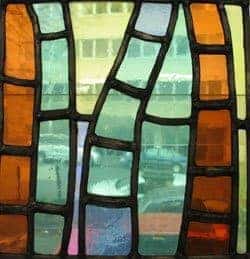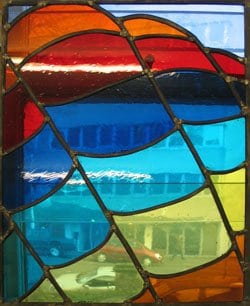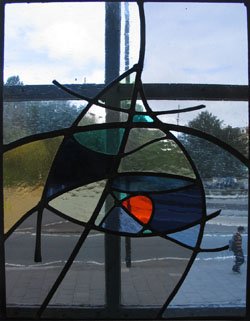A Selection of First Stained Glass Windows
So far the stained glass art I’ve shown in this section of my website has been made by artists who use advanced techniques, such as etching and painting.

But not here. Here I’m paying homage to my students, who have surprised and delighted me over the years with their inventiveness and willingness to ‘give it a go’.
Learning how to make stained glass art means learning lots of very different new skills – cutting, leading and soldering to name but a few.
This first piece of stained glass art (above) was inspired by bamboo shoots. Notice that the student, Sue Daniel, has experimented with different lead came thicknesses to emphasise the horizontal aspects of her design.

Designing stained glass art can be tricky too. Technical and aesthetic considerations run side by side.
For example, you have to make sure that each shape is ‘cuttable’, that the colours work together well. Nor can you forget the visual impact of the lead lines.
I think this panel manages to balance these elements perfectly.
Inspired by hot air ballooning, it captures the billowing effect of the wind by curving the lead came and by using the colours to create a rounded voluminous form. It’s great, and makes me feel like I’m floating away.

The colours Vicky Liddiard used in her first panel are unusual because of their subtlety.
It’s easy to be seduced by all the bright primary colours, but this piece of stained glass art derives it’s strength from restrained use of colour.
That tiny bit of orange in the centre fairly shouts out at you, surrounded as it is by muted greys and blues.
In case you’re wondering how those bits of lead stop in the middle of nowhere, they’re called ‘false’ leads.
The heart of the lead came is removed and the flanges simply stuck on the art glass and cemented in as normal. It’s a technique first started in Germany by Johannes Schreiter.
I hope you’ll feel inspired by these panels to have a go yourself.


need help curving with came
new working with stain glass so need to learn
also my sodering is showing black why???
thanks
Catherine C
Hi Catherine, a lead came bender is a good idea if it’s zinc came you’re trying to bend. If it’s lead came you should be able to do this by hand – you ‘feed’ the came into the curves by pushing and releasing until the stained glass lead takes up the shape of the glass.
Or you can hold the stained glass shape in one hand and bend the lead around the glass before cutting.
I’m not sure what you mean about the solder – there’s a page about polishing up lead came panels here and one on polish and patina for copper foil here.
I hope that helps.